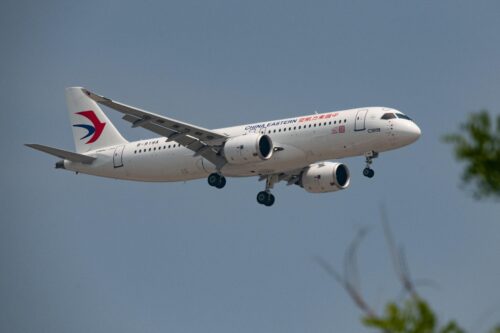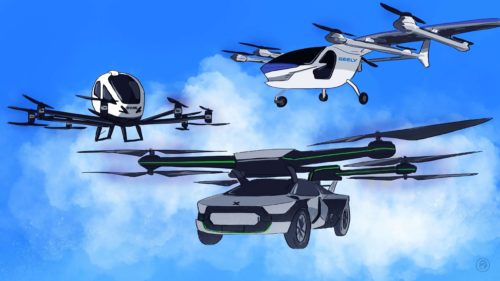Big planes, fighter jets, drones, and rockets at the Zhuhai Airshow
This year's airshow featured a scale model of China’s space station, huge transport planes, drones, jets, and attack helicopters, and more than $35 billion worth of deals for planes and aviation equipment.

The Zhuhai Airshow took place in Guangdong Province on November 8 to 13. Also known as the 14th China International Aviation and Aerospace Exhibition, this year’s show included a total of 740 local and foreign companies from 43 countries, exhibiting both online and offline. There were more than 110 aircraft taking part in live flight demonstrations and on display in an indoor exhibition area of 100,000 square meters (1.07 million square feet).
Since the very first Zhuhai Airshow in 1996, the event has displayed aircraft from around the world, but has also provided regular glimpses into China’s progress with airborne technology, including planes, drones, rockets, and other technologies.
Fighter jets, tanker planes, drones, and Moon rocks
All China’s large aviation industry conglomerates were at the event, together with the world’s leading aircraft manufacturers, including Boeing, Airbus, and Embraer. But the highlights of every Zhuhai Airshow show are new Chinese planes, usually fighter jets, that visually display the progress of Chinese technology with rolling thunder and a bone-jarring rumble.
At the 1996 airshow, the Chinese star, the Shenyang J-8IIB, with the nickname “handsome man of the air” (空中美男子 kōngzhōng nánzǐ) — the latest version of a fighter jet produced in China (but based on the Soviet Mig-21) that originally entered service in 1980 — was hobnobbing with the latest fourth-generation Russian fighter jets and a British aerobatics team.
At the 2016 Zhuhai Airshow, however, the Chinese challenger was no longer just a copycat. China used the show for the first public demonstration of the Chengdu J-20, the world’s third operational fifth-generation stealth fighter (after the F-22 and F-35 produced by the U.S. corporation Lockheed Martin), the latest and most advanced airplanes in the world.
At this year’s airshow, a Chinese aerobatics team of six Chengdu J-10 fighters made an appearance. A lot of buzz was also generated by a large transport plane: The bulky Y-20 Kūnpéng (鲲鹏), nicknamed “fat girl” (胖妞 pàng niū), is the largest military aircraft ever built in China. The plane first entered service in 2016, but a new variant of this plane made its first appearance in Zhuhai this year: the YU-20 (运油 Yùnyóu) tanker, which can hold more than 100 tons of fuel, and can disgorge 50 tons to other planes with in-flight refueling, a new capability for the People’s Liberation Army Air Force.
The other challenger for star of the show this year was a lifesize simulated exhibition of China’s manned space station by the China Aerospace Science and Technology Corporation (CASC), including the core and the two modules, displayed in a T-shaped layout. Visitors were allowed to enter the “space station,” where they could observe a display of Chinese astronauts eating noodles, beef, and rice dumplings.
Another curiosity this year was an exhibition of lunar samples displayed by the China National Space Administration, including a chunk of Changesite-(Y) (嫦娥石 chángéshí), a new mineral discovered by the Chang’e 5 robotic mission on the Moon, as announced in September 2022.
Another relatively new local favorite this year was the Z-20 “Divine Eagle” (神雕 shéndiāo) attack helicopter, which entered service in 2019, and is manufactured by Harbin Aircraft Industry Group, a subsidiary of Aviation Industry Corporation of China (AVIC).
Drones, both for aviation and marine uses, were especially prominent this year:
- The latest variant of the Wing Loong (翼龙 Yì Lóng) drone, the 1E, first flew in January 2022 and has a larger carrying capacity than previous models. It is produced by another AVIC subsidiary, Chengdu Aircraft Industry Group.
- The FH 97A (飞鸿 Fēihóng) drone, which looks like a modern fighter jet, made a splashy debut at Zhuhai this year. Developed by the China Aerospace Science and Technology Corporation (CASC) 中国航天科技, this is a type of “loyal wingman” drone that accompanies manned aircraft and provides intelligence and firepower support.
- The Tiānchéng (天乘) 001 “integrated system” drone manufactured by Guangzhou Haige Communications Group can navigate “heterogeneous terrain and complex environments” with the ability to make rapid ascents and descents.
- The Sea Thunderbolt (海霹雳 Hǎi Pílì) is an unmanned surface vehicle (USV) for use at sea manufactured by China Aerospace Science and Industry Corporation (CASIC), China’s largest missile manufacturer, and Yunzhou Intelligence Technology. The Sea Thunderbolt has a length of 22 meters (72 feet), and can be manned or be operated fully autonomously.
China news, weekly.
Sign up for The China Project’s weekly newsletter, our free roundup of the most important China stories.
Deals worth more than $35 billion
As the extent of Chinese tech at Zhuhai has expanded, so has the amount of business undertaken at the airshow. The 2022 edition was awash with “Made in China” technology, and set a new record for business deals: From a mere $2 billion of deals signed at the 1996 Zhuhai Airshow, this year, the amount reached $35.16 billion.
France’s Airbus was there, with the latest A321neo airliner (which will soon be produced at the company’s assembly line in Tianjin), while the 737-800 Boeing Converted Freighter (BCF) did service for the Seattle-based Boeing. Brazilian manufacturer Embraer brought the largest airliner in its E-Jet family, the E195-E2. A smaller version in this series, the E190-E2, has just been approved for use in China.
The world’s leading engine manufacturers were also there in force — although this is one particular area where there are as yet no local champions — including the France-U.S. joint venture CFM International, the U.S. corporations Pratt and Whitney and GE Aviation, and Rolls-Royce of the U.K.
The contracts signed at this year’s event included the sale of 549 aircraft, an increase of 245% compared with the previous airshow that took place in September–October 2021 (originally scheduled for 2020 but delayed due to COVID). A total of 350 Chinese aircraft were reportedly sold this year, including 300 of the new C919 airliner built by Commercial Aircraft Corporation of China (COMAC), although the customers were all Chinese leasing companies. For its smaller ARJ21 regional airliner, COMAC signed overseas orders for 30 planes.
Some of the other deals signed at this year’s airshow included the following:
- GE Aviation signed a deal with TAECO Xiamen (a subsidiary of Hong Kong Aircraft Engineering Company, HAECO) on the CF34-10A thrust class turbofan engine used in the ARJ21, meaning that the ARJ21 airliner can in future be fully serviced in China.
- Boeing signed an agreement with COMAC to expand cooperation on the joint research center they established in 2012, the Boeing-COMAC Sustainable Aviation Technology Center.
- Sichuan Haite High-tech, a company that manufacturers flight simulators and aircraft engine electronics control systems, signed a deal with the Civil Aviation Administration of China for the development of 5G microchips.
- Haite JV ACCEL Flight Simulation signed a deal with French company Thales Group on electric vertical takeoff and landing (eVTOL) technology for future use in urban air travel.






